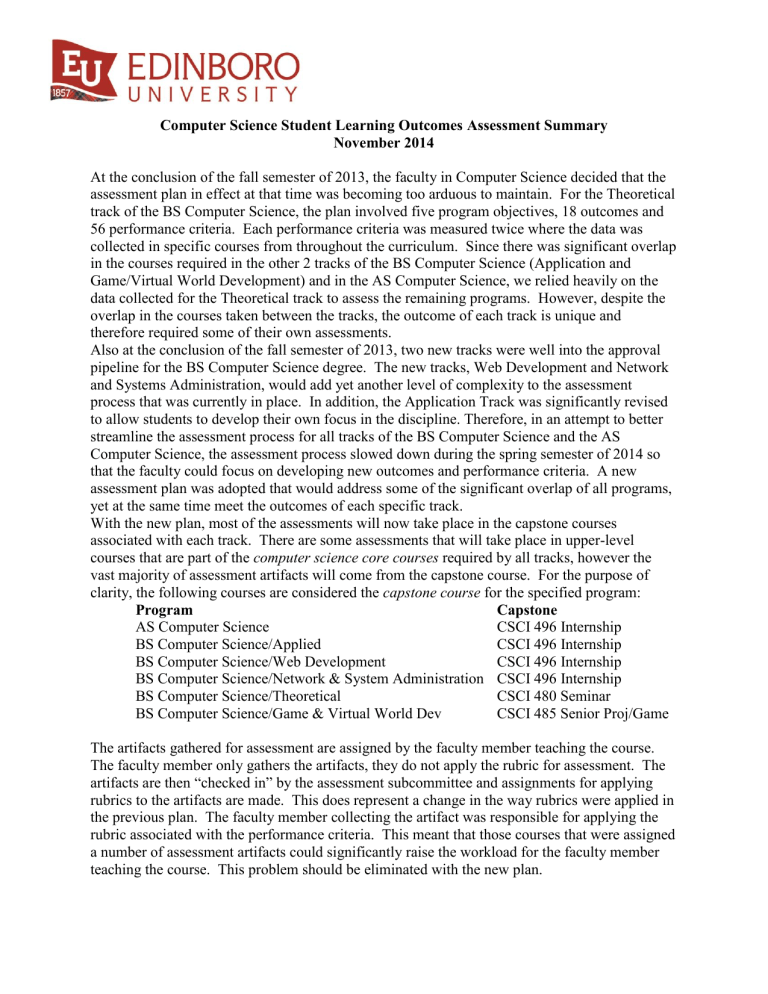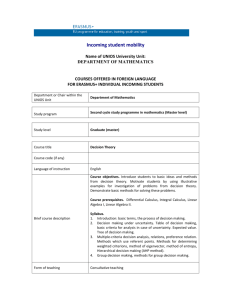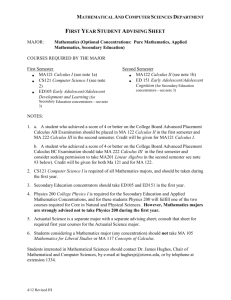Computer Science Student Learning Outcomes Assessment Summary November 2014

Computer Science Student Learning Outcomes Assessment Summary
November 2014
At the conclusion of the fall semester of 2013, the faculty in Computer Science decided that the assessment plan in effect at that time was becoming too arduous to maintain. For the Theoretical track of the BS Computer Science, the plan involved five program objectives, 18 outcomes and
56 performance criteria. Each performance criteria was measured twice where the data was collected in specific courses from throughout the curriculum. Since there was significant overlap in the courses required in the other 2 tracks of the BS Computer Science (Application and
Game/Virtual World Development) and in the AS Computer Science, we relied heavily on the data collected for the Theoretical track to assess the remaining programs. However, despite the overlap in the courses taken between the tracks, the outcome of each track is unique and therefore required some of their own assessments.
Also at the conclusion of the fall semester of 2013, two new tracks were well into the approval pipeline for the BS Computer Science degree. The new tracks, Web Development and Network and Systems Administration, would add yet another level of complexity to the assessment process that was currently in place. In addition, the Application Track was significantly revised to allow students to develop their own focus in the discipline. Therefore, in an attempt to better streamline the assessment process for all tracks of the BS Computer Science and the AS
Computer Science, the assessment process slowed down during the spring semester of 2014 so that the faculty could focus on developing new outcomes and performance criteria. A new assessment plan was adopted that would address some of the significant overlap of all programs, yet at the same time meet the outcomes of each specific track.
With the new plan, most of the assessments will now take place in the capstone courses associated with each track. There are some assessments that will take place in upper-level courses that are part of the computer science core courses required by all tracks, however the vast majority of assessment artifacts will come from the capstone course. For the purpose of clarity, the following courses are considered the capstone course for the specified program:
Program
AS Computer Science
Capstone
CSCI 496 Internship
BS Computer Science/Applied
BS Computer Science/Web Development
CSCI 496 Internship
CSCI 496 Internship
BS Computer Science/Network & System Administration CSCI 496 Internship
BS Computer Science/Theoretical CSCI 480 Seminar
BS Computer Science/Game & Virtual World Dev CSCI 485 Senior Proj/Game
The artifacts gathered for assessment are assigned by the faculty member teaching the course.
The faculty member only gathers the artifacts, they do not apply the rubric for assessment. The artifacts are then “checked in” by the assessment subcommittee and assignments for applying rubrics to the artifacts are made. This does represent a change in the way rubrics were applied in the previous plan. The faculty member collecting the artifact was responsible for applying the rubric associated with the performance criteria. This meant that those courses that were assigned a number of assessment artifacts could significantly raise the workload for the faculty member teaching the course. This problem should be eliminated with the new plan.
The new plan preserves the five original program outcomes. These outcomes are associated with the BS Computer Science (all tracks) and the AS Computer Science. The five program objectives are:
Graduates of the Programs in Computer Science will:
1.
Be able to apply the tools, theory and practices of computer science.
2.
Be able to apply critical thinking, analytical and logical skills to solve problems.
3.
Possess the ability to communicate in a professional manner.
4.
Recognize and understand the professional, social and ethical responsibilities associated with computer science.
5.
Recognize the need for continuous learning.
Mathematics Program Assessment: Fall 2014
In this round of mathematics program assessment (2013–2014), we have had a variety of activities and changes:
We collected and analyzed data regarding Objective 1, regarding fundamental concepts of mathematics. We plan to gather further data on part of this objective.
We began a preliminary assessment for the additional objective 5 for the actuarial track, using a tool designed last year. We are revising the tool to repeat the assessment in the spring actuarial seminar.
We have begun data collection for Objective 3, regarding students’ ability to interpret, solve, and communicate the results of mathematical problems. Responding to suggestions from the 2010 report, we have developed a variety of new approaches to assessing this objective. Analysis in the spring will determine how we move forward.
We have seen the approval of a major curricular change, with the introduction of a new course (Math 290) designed to address the particular weakness we identified in earlier assessments regarding mathematical proofs. The change took place as we moved from a
BA degree to a BS.
New Assessment
We begin with new data collection and analysis for Objective 1 from the 2013–2014 year, a new assessment for an actuarial track objective, and implementation of new approaches to assessment for Objective 3. We are undergoing some overhaul in all of these areas, with further data collection planned for Objective 1, new types of assessment underway for Objective 3, and a revision to a preliminary assessment tool first implemented last semester.
Objective 1 Assessment
In fall 2013 and spring 2014, we collected data to assess Objective 1:
1. Graduates will be able to explain the fundamental concepts of a.
real analysis of one variable b.
calculus of several variables and vector analysis c.
linear algebra and the theory of vector spaces d.
probability and statistics e.
abstract algebra
This objective was last addressed in the 2010 assessment report.
Questions were delivered to students embedded in a test or quiz in a course. (Courses each objective was assessed in are listed with the question data.) Each student response was assigned a score on a 0–5 scale by the consensus of two mathematics faculty members, ranging from a 0 for a blank paper to a 5 for a perfect response. (See Appendix B.) Data from the student responses are reported below. Each table begins with:
A description of the question.
The course in which the question was asked.
The particular objectives (1a–e) tested by the question.
Following the heading is the chart of responses, containing:
The number of students with a given score from the 2010 report.
The percent of responses at that level from the 2010 data.
A cumulative response: The percentage who scored at a given score or higher in 2010.
The same results from the 2014 report data for the same question, together with the percentage response and cumulative column are then presented.
In some cases, data gathered from the calculus sequence (Math 211, 212, and 311) in the 2010 report has been assessed in both the calculus sequence and Real Analysis (Math 411), or in some cases, only in Math 411, as we continue work from last year to include assessments as near the end of the program as possible.
Analysis of data: Some of the results obtained in the past year show only a little fluctuation from the first round of assessment. In particular, problem 7 (on probability, going from a mean of 4.1 to a mean of 3.9), problem 6 (on spanning sets, going from a mean of 3.3 to a mean of
3.9), and problem 5 (on subspaces, going from a mean of 2.2 to a mean of 2.7), are about the same.
We note that problems 6 and 7 represent fairly good responses, while problem 5 was weak in
2010 and remains so. Problem 5 in particular is a more abstract problem, and closer to a proof than some of the others. We noted in response to assessment of Objective 2 last year that students had the most difficulty with abstract, multi-part problems, and encouraged faculty to be sure to give the students more practice with these. (Problem 5 is also closer to a proof, which our students particularly struggle with. Current changes in response to that weakness are discussed later.)
Responses to problems 1 and 2 were a little weaker in 2014, with the more advanced analysis students unfortunately lagging calculus students in definitions, but showing greater facility in applying their knowledge in problem 2.
The real analysis students from spring semester 2014 in fact surprisingly seem to lag the students in the calculus sequence in almost every comparison. The results on the multivariable calculus questions (problems 3 and 4 above) showed particularly poor results from the analysis students, who scored a mean about half that of the Math 311 students in the 2010 report. (Due to logistical problems, data from Math 311 in fall 2014 is not available for direct comparison.)
We are not sure if this indicates a fall off of calculus knowledge among upper level students, a decrease in achievement since 2010, or simply reflects an unfortunate batch of about 12 poor scores in the spring 2014 data. In order to better understand the phenomenon, we will be reporting data gathering in Math 411 this spring as well as in Math 311. We will be analyzing this data again in the spring and fall of next year to determine how to proceed with regards multivariable calculus.
We further note that the difference between the responses of the Math 411 students and the students earlier in the sequence is in distinct contrast to the data in last year’s report on
Objective 2. At that time, we began comparing the responses of students in senior courses such
as Math 411 to the responses in sophomore and junior courses. At that time, we found that the responses from the seniors were not particularly different from the responses of students a bit earlier in the program.
Senior Surveys
Only one senior survey was returned from a graduating senior last year. As we did before, we are collecting a set of several years of surveys before we make any significant analysis.
Actuarial Surveys
In last year’s report, we noted that we were starting an assessment of additional objective 5 for the actuarial track, which states
A5. Students will gain an understanding of professional opportunities and responsibilities of the future actuary.
We asked students in the spring 2014 actuarial seminar (which is taken at the end of the program) to respond to the following question:
Describe your perception of the professional opportunities and responsibilities of an actuary.
We received seven responses. The same question was asked of three incoming students in fall semester 2014.
Common themes in both sets of data included work in the insurance industry, risk analysis, and the importance of professional exams. Many responses were somewhat vague, although the responses from the finishing students did tend to be more detailed than the incoming students.
The professor teaching the actuarial seminar commented that he thought the students may not have understood the question. We are discussing how the question may be made more specific.
Some preliminary suggestions include asking the students the following:
“Describe the testing procedure for actuaries, as you understand it.”
“Who hires actuaries?”
We will be working with some of our professors teaching in the actuarial track (and perhaps reaching out to alumni in the profession) to revise and focus these questions so we can try another round of this assessment in the spring 2015 actuarial seminar.
Data Collection for Objective 3
Objective 3 states:
Graduates will be able to interpret and solve mathematical problems by a.
selecting appropriate mathematical tools b.
selecting and implementing technology when appropriate c.
communicating the results in written and oral form
As we noted in last year’s report, the assessment committee did not believe that our previous approach (using embedded test questions) adequately addressed this objective. In particular, since this objective deals with our students’ ability to wrestle with a problem, develop approaches to solving it, and communicating the results, test questions poorly address this objective.
This year, we have developed a number of alternative approaches to assessing this objective:
Students in Math 360 in spring semester 2014 were given an open-ended statistical analysis question involving technology, and asked to write up both their solution and a brief discussion of why they chose whatever technology they selected. These results will
be analyzed for both part b (regarding selecting technology) and part c (regarding communicating results in written form).
A take-home write up assignment was collected from both Math 411 and Math 421 in spring semester to analyze for part c, regarding communicating in written form.
Students in the mathematics seminar this semester are giving presentations on various topics. Several members of the assessment committee are currently observing these presentations to address the students’ oral communication for part c.
A subcommittee is attempting to develop an open-ended and possibly ill-posed question for students to try wrestling with in the mathematics seminar for one class at the end of the semester. Observing such a process and its results could help in part a, regarding selecting appropriate mathematical tools.
For part a, we are also giving consideration to selecting a few problems with multiple approaches to give to students in Math 212 (Calculus II) and Math 275 (Linear Algebra), in which there is often an issue of choosing an appropriate technique to solve a problem.
At the end of the year, we should have a better handle on how some of these various techniques worked, what we will be using in the future, and how our students are faring with Objective 3.
Changes, Actions, and Recommendations
Objective 1: Fundamental Concepts
As indicated above, we will be repeating data gathering on Objective 1b, regarding multivariable calculus, before moving forward on this point, but it may be that we will need to address a weakness in this particular area.
We also make the following recommendations regarding Objective 1 overall:
As we noted last year, students show the most weakness in problems which involve the most abstract thinking. We wish to reemphasize our call last year for professors to continue to provide students with practice with these types of problems. Additionally, the work by the curriculum committee on the teaching of proofs (below) may be helpful here.
Although the responses on question one (regarding some definitions) are not exceptionally low, we feel that our students should be near perfect on this point, since it involves simply making sure to memorize important definitions. This should be achievable by all students, and a proper understanding of definitions is critical to a mathematics major. Therefore, we call on our colleagues to redouble the emphasis on proper understanding of definitions in all courses for majors.
Objective 3: Interpret, Solve, and Communicate Results
We note that we are in the process of responding to calls from the 2010 assessment report to reconsider appropriate methods of assessing this objective. Details are provided (above) in the section on data collection. We will be determining how to move forward in the future on this objective in spring 2015.
Objective 4: Students’ Understanding of Proof
In last year’s assessment report, we discussed ongoing discussions and changes to the program to attempt to address Objective 4, concerning students’ understanding of mathematical proof.
This objective has generated the weakest results of any of our objectives in two separate rounds of assessment. It should be noted that this weakness is not exclusive to Edinboro, but the transition to mathematical proof is considered a thorny issue in undergraduate mathematics education nationally.
Last year’s report noted a tweaking of Math 275 (Linear Algebra) to increase emphasis on proof techniques . The following is from the Rationale section of the Math 275 curriculum document:
In response to recent assessments of our mathematics programs, it was determined that further emphasis on proof concepts is needed.
The changes to Math 275 were approved at the university level in May 2014.
We also noted in last year’s report that the department curriculum committee opted not to make major changes to the senior seminar (as originally suggested by the assessment committee, but that curriculum was taking advantage of a change from a BA to a BS degree in mathematics to introduce a new course focusing exclusively on mathematical proof. Course development proceeded rapidly since last year’s report, and Math 290, (Foundations of Mathematical Proof) was approved by the department in February of 2014. The Rationale portion of the curriculum document reads (in entirety):
Assessment has shown that students struggle with upper level proof classes. This course is designed to introduce the students to the idea of mathematical proofs more gently. Ideally, the students will grasp mathematical proof better and therefore be able to perform better in the upper level proof courses, alleviating the need for students to take the upper level proof courses multiple times each, in some cases.
The course was also approved at the university level in May 2014, and is part of the required courses for the new BS in pure Mathematics as well as the Mathematics major with Actuarial
Concentration, which began with incoming new students this year. Math 290 will be offered for the first time in spring semester 2016.




